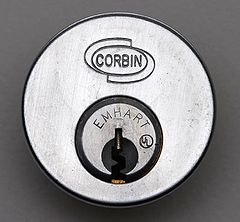Corbin Emhart
Corbin Emhart
| Corbin Emhart | |
 | |
| Name | Corbin Emhart |
|---|---|
| Manufacturer | Corbin Russwin |
| Lock Type | Cylinder |
| Lock Design | Pin-tumbler |
| Year(s) Produced | 1978 - Present |
| Patent | US 4,098,103 US 4,103,526 US 4,208,894 |
The Emhart is a UL 437 rated pin-tumbler lock made by Corbin Russwin. The Emhart is best known for having interlocking pins that provide resistance to lockpicking and make the lock immune to key bumping attacks. The Emhart is one of the few pin-tumbler locks that uses axial rotation as one of its key control and pick-resistance features.
The Emhart is still produced but only existing systems are supported. Corbin Russwin lost a case filed by Medeco in 1975 which claimed the Emhart design, particularly the use of axial rotation, infringed upon Medeco's patents. The case was settled in 1977 and forced Corbin Russwin to pay Medeco royalties on each Emhart sold until March of 1987.
The Emhart has since been superceded by the Corbin Russwin Pyramid.
Principles of operation
The Emhart is a pin-tumbler lock that uses six pin stacks. The driver pins of the Emhart have a T shaped protrusion, with a matching gap on the top of the key pins. These two points interlock, requiring that pins move together until they are disconnected. When pin stacks are properly raised and rotated, movement of the plug causes the pin stacks to disconnect, trapping each driver pin above the shear line. Driver pins maintain their position by being trapped in grooves around the plug. These grooves double as protection against various forms of destructive entry, as well. The key contains cuts that mirror the grooves in the plug, allowing the plug to rotate completely while keeping the driver pins in the proper position.
The tips of key pins are chiseled at various angles and mate with angled bitting cuts on the key. These cuts provide axial rotation which is necessary to properly rotate the pin stacks.
The Emhart uses a variable MACS based on the angle of rotation between pins. Adjacent pins with the same angles use a MACS of 4, adjacent pins with different angles use a MACS of 3.[1]
Pins properly aligned at the shear line.
The grooved plug holds driver pins when rotated.
Components
Master Keying Kit No. W70A for Emhart High Security Locking System with Interlocking Pin Tumblers
- #2 (1) Tumbler Pin 407T41-4242
- #2 (2) Tumbler Pin 407T42-4242
- #3 (1) Tumbler Pin 407T41-4270
- #3 (2) Tumbler Pin 407T42-4270
- #4 (1) Tumbler Pin 407T41-4298
- #4 (2) Tumbler Pin 407T42-4298
- #5 (1) Tumbler Pin 407T41-4326
- #5 (2) Tumbler Pin 407T42-4326
- #6 (1) Tumbler Pin 407T41-4354
- #6 (2) Tumbler Pin 407T42-4354
- Driver Pin 407T43-4193
- Driver Pin 407T43-4158
- #2 (1) Master Pin 407T31-4097
- #2 (3) Master Pin 407T33-4097
- #2 (2) Master Pin 407T32-4097
- #3 (1) Master Pin 407T31-4125
- #3 (3) Master Pin 407T33-4125
- #3 (2) Master Pin 407T32-4125
- #4 (1) Master Pin 407T31-4153
- #4 (3) Master Pin 407T33-4153
- #4 (2) Master Pin 407T32-4153
- Springs 401F87-7
- Slides 217F44
The last 3 digits of the part number are the pin length, in thousandths of an inch, including the tab.
Dissassembly instructions
The Emhart is relatively easy to disassemble, but it cannot be disassembled in as many ways as traditional pin-tumbler locks. Most importantly, the plug cannot be removed with a traditional plug follower because of the interlocking pins and the ribbed plug. Pin stacks must be installed and removed from the pin chambers only.
Vulnerabilities
The Emhart may be vulnerable to one or more of the following:
Notes
- The Emhart is immune to key bumping due to the interlocking pins.
- Traditional picking techniques disconnect the pins and leave no easy way to reconnect them (unless the lock is mounted vertically up, see talk page), effectively making the lock non-functional. Overcoming this requires that after the plug is rotated to open the lock the key pins can be raised and rotated back to a position where they can re-engage the driver pins.
- Certain forms of destructive entry, particularly forced removal of the plug, are much harder due to the design of the interlocking pins and the grooved plug.
Gallery
References
- ↑ PULFORD, Graham (2007). High Security Mechanical Locks: An Encyclopedic Reference. ISBN 0750684372.











